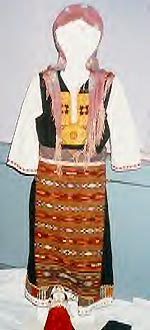
| |||||||
| |||||||
MAP | GREEK VERSION | ONLY TEXT | CREDITS |
 |
COSTUMES FROM THRACE | |
|
KAROTI The main components of the costume worn in Karoti, and in other villages where the same costume type is observed, is a home-made cotton chemise, embroidered around the hem line. A blue sleeveless, single-paneled, heavy cotton dress, the tsoukna, which had two openings to facilitate breast- feeding, was worn over the chemise. Another distinctive feature to the costume is the bronze belt, known as the bakirozounaro, accentuated by its ornamental bronze and enamel buckle, known as the korona. This type of belt is encountered only in the area of Thrace, and is hand-made by Thracean goldsmiths, called kouyioumtzides. The apron is wool, hand-woven with a geometrical design and sequins were applied to keep the Evil-Eye away. The costume also includes a beautiful head-dress known as the bourboula. As a bridal costume, the color red is very predominant. Above the chemise a short red jacket is added. The sleeves of the jacket are adorned with yellow, green and blue needle-work. The woman's hair is also braided with brightly-colored ribbons. Real hair- pieces were added to lengthen the woman's hair. The head-piece consists of three scarves: the first, blue in color, covered the forehead; the second, yellow in color, fringed, draped under the chin and tied at the crown; the third, white in color, triangle in shape, was placed on top of the first two. To decorate the head-piece further, a rectangular hand-beaded piece was added to the left side of the temple. Coins were used to accent the forehead and adorn the bosom. Stockings were knitted from thick wool. Cloth slippers completed the ensemble. | |
|
KAVAKLI The people of Kavakli arrived as refugees in 1906 and settled in a number of villages. The region was in Northern Thrace, which today is in Bulgaria. The women wove and embroidered their clothes themselves with stitching of exquisite quality. The shirt reached half way down the calf. the upper part was made of deep blue woven cotton cloth and the skirt of white. The embroidery around the neck, cuffs and hem was done using multi-colored threads of silk or wool. The sleeveless woolen garment worn over this was dyed a deep blue. The opening of the bodice was richly embroidered with brightly colored threads. The women pleated their skirt, decorating the hem with stripes of silk, gold braid and embroidery. The four-meter-long sash was usually red with multi-colored stripes and sewn on the slant for a better fit at the waist. Over it was tied a woolen apron with its woven decoration. It was possible to distinguish between married or single women, mothers or women in mourning just by looking at the type of apron worn. In winter the women wore a sleeveless topcoat made of woven wool, which was modestly stitched and embroidered around the hem. On their head a little fez was shrouded with a printed woolen scarf folded into a bend. Over this was thrown a large printed scarf with a fringe, the ends hanging down loose. The bapka, a decoration consisting of 5, 10 or even 15 coins, arranged in the shape of cross, was attached to the fez and hung down over the forehead. The costume continued to be worn in Greece as well, but simplified bit by bit until it was finally abandoned altogether. It belongs to the category of village type costumes. | |

|
METAXADES The poor quality of the soil of the Florina plateaus, prevented the local residents from wearing clothing of expensive material. The nearby forest offered some resources, such as timber, charcoal and bee-keeping, but the people lived a life of deprivation and hardship. The women wove their own cotton and woolen cloth from which they sewed their simple, austere dresses. The white cotton chemise was embroidered around the hem line and on the sleeves with colored threads. The opening of the front of the chemise was bordered by brightly-colored fabric. A floral patterned jabot of bought fabric was placed at the opening of the bodice. A black woolen, sleeveless overcoat, the sigouni, was worn over this. This overcoat was embroidered around the neck and on the front with brightly-colored threads. The sash, approximately two meters in length, was made of black wool and tied around the waist at the top of the apron. The black and red apron was always home spun and woven. The simple black scarf, placed upon the head, was adorned with a string of pearls. These pearls were considered to be part of the dowry. |